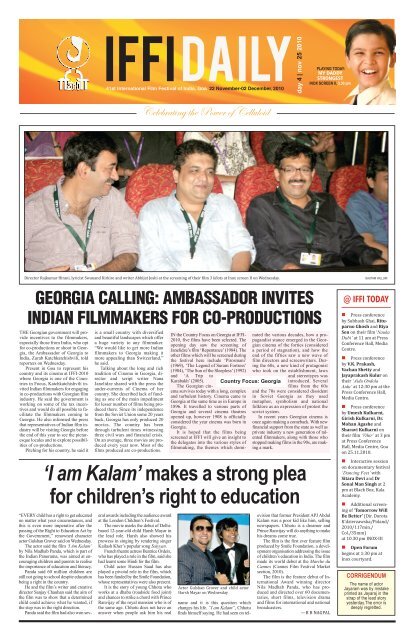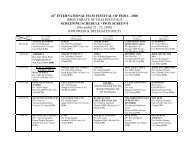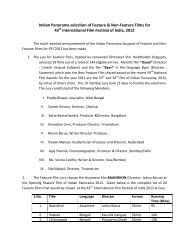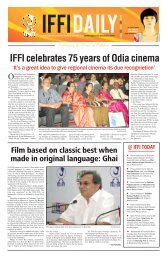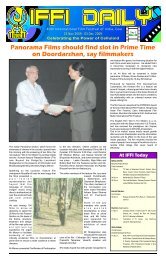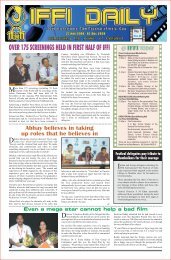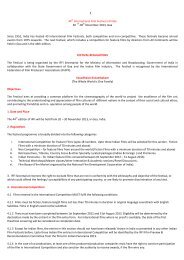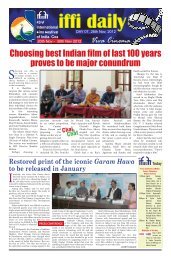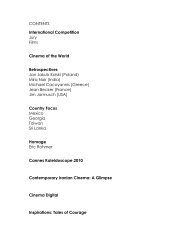Day 4 - International Film Festival of India
Day 4 - International Film Festival of India
Day 4 - International Film Festival of India
You also want an ePaper? Increase the reach of your titles
YUMPU automatically turns print PDFs into web optimized ePapers that Google loves.
IFFIDAILY<br />
41st <strong>International</strong> <strong>Film</strong> <strong>Festival</strong> <strong>of</strong> <strong>India</strong>, Goa 22 November-02 December, 2010<br />
day 4 | nov 25 2010<br />
PLAYing TodAY:<br />
MY DADDY<br />
STRONGEST<br />
inoX SCreen ii, 3.30 pm<br />
Celebrating the Power <strong>of</strong> Celluloid<br />
Director Rajkumar Hirani, lyricist Swanand Kirkire and writer Abhijat Joshi at the screening <strong>of</strong> their film 3 Idiots at Inox screen II on Wednesday.<br />
GEORGIA CALLING: AMBASSADOR INVITES<br />
INDIAN FILMMAKERS FOR CO-PRODUCTIONS<br />
THE Georgian government will provide<br />
incentives to the filmmakers,<br />
especially those from <strong>India</strong>, who opt<br />
for co-productions or shoot in Georgia,<br />
the Ambassador <strong>of</strong> Georgia to<br />
<strong>India</strong>, Zurab Katchkatchishvili, told<br />
reporters on Wednesday.<br />
Present in Goa to represent his<br />
country and its cinema at IFFI-2010<br />
where Georgia is one <strong>of</strong> the Countries<br />
in Focus, Katchkatchishvili invited<br />
<strong>India</strong>n filmmakers for engaging<br />
in co-productions with Georgian film<br />
industry. He said the government is<br />
working on some <strong>of</strong> the tax incentives<br />
and would do all possible to facilitate<br />
the filmmakers coming to<br />
Georgia. He also informed the press<br />
that representatives <strong>of</strong> <strong>India</strong>n film industry<br />
will be visiting Georgia before<br />
the end <strong>of</strong> this year to see the picturesque<br />
locales and to explore possibilities<br />
<strong>of</strong> co-productions.<br />
Pitching for his country, he said it<br />
is a small country with diversified<br />
and beautiful landscapes which <strong>of</strong>fer<br />
a huge variety to any filmmaker.<br />
“We would like to get more <strong>India</strong>n<br />
filmmakers to Georgia making it<br />
more appealing than Switzerland,”<br />
he said.<br />
Talking about the long and rich<br />
tradition <strong>of</strong> Cinema in Georgia, director<br />
and script writer Nana<br />
Janelidze shared with the press the<br />
under-currents <strong>of</strong> Cinema <strong>of</strong> her<br />
country. She described lack <strong>of</strong> funding<br />
as one <strong>of</strong> the main impediment<br />
for lesser number <strong>of</strong> films being produced<br />
there. Since its independence<br />
from the Soviet Union some 20 years<br />
back, Georgia has only produced 20<br />
movies. The country has been<br />
through turbulent times witnessing<br />
three civil wars and financial crisis.<br />
On an average, three movies are produced<br />
every year now. Most <strong>of</strong> the<br />
films produced are co-productions.<br />
“EVERY child has a right to get educated<br />
no matter what your circumstances, and<br />
this is even more imperative after the<br />
passing <strong>of</strong> the Right to Education Act by<br />
the Government,” renowned character<br />
actor Gulshan Grover said on Wednesday.<br />
The actor said the film ‘I Am Kalam’<br />
by Nila Madhab Panda, which is part <strong>of</strong><br />
the <strong>India</strong>n Panorama, was aimed at encouraging<br />
children and parents to realise<br />
the importance <strong>of</strong> education and literacy.<br />
Panda said 60 million children are<br />
still not going to school despite education<br />
being a right in the country.<br />
He and the film’s writer and creative<br />
director Sanjay Chauhan said the aim <strong>of</strong><br />
the film was to show that a determined<br />
child could achieve what he wanted, if<br />
the step was in the right direction.<br />
Panda said the film had also won several<br />
awards including the audience award<br />
at the London Children’s <strong>Festival</strong>.<br />
The movie marks the debut <strong>of</strong> Delhibased<br />
12-year-old child Harsh Mayar in<br />
the lead role. Harsh also showed his<br />
prowess in singing by rendering singer<br />
Kailash Kher’s popular song Saiyyan.<br />
French theatre actress Beatrice Ordeix,<br />
who has played a role in the film, said she<br />
had learnt some Hindi for the film.<br />
Child actor Hussan Saad has also<br />
played a pivotal role in the film, which<br />
has been funded by the Smile Foundation,<br />
whose representatives were also present.<br />
It is the story <strong>of</strong> young Chhotu who<br />
works at a dhaba (roadside food joint)<br />
and chances to strike a chord with Prince<br />
Ranvijay <strong>of</strong> the royal mansion who is <strong>of</strong><br />
the same age. Chhotu does not have an<br />
answer when people ask him his real<br />
IN the Country Focus on Georgia at IFFI-<br />
2010, five films have been selected. The<br />
opening day saw the screening <strong>of</strong><br />
Janelidze’s film ‘Repentance’ (1984). The<br />
other films which will be screened during<br />
the festival here include ‘Pirosmani’<br />
(1969), ‘The Legend <strong>of</strong> Suram Fortress’<br />
(1984), ‘The Sun <strong>of</strong> the Sleepless’ (1992)<br />
and ‘A Trip to<br />
Karabakh’ (2005).<br />
The Georgian cinema<br />
survives today with a long, complex<br />
and turbulent history. Cinema came to<br />
Georgia at the same time as in Europe in<br />
1896. It travelled to various parts <strong>of</strong><br />
Georgia and several cinema theatres<br />
opened up, however 1908 is <strong>of</strong>ficially<br />
considered the year cinema was born in<br />
Georgia.<br />
It is hoped that the films being<br />
screened at IFFI will give an insight to<br />
the delegates into the various styles <strong>of</strong><br />
filmmaking, the themes which dominated<br />
the various decades, how a propagandist<br />
stance emerged in the Georgian<br />
cinema <strong>of</strong> the forties (considered<br />
a period <strong>of</strong> stagnation), and how the<br />
end <strong>of</strong> the fifties saw a new wave <strong>of</strong><br />
film directors and screenwriters. During<br />
the 60s, a new kind <strong>of</strong> protagonist<br />
who took on the establishment, laws<br />
and stereotypes was<br />
introduced. Several<br />
films from the 60s<br />
and the 70s were considered dissident<br />
in Soviet Georgia as they used<br />
metaphor, symbolism and national<br />
folklore as an expression <strong>of</strong> protest the<br />
soviet system.<br />
In recent years Georgian cinema is<br />
once again making a comeback. With new<br />
financial support from the state as well as<br />
private industry a new generation <strong>of</strong> talented<br />
filmmakers, along with those who<br />
stopped making films in the 90s, are making<br />
a mark.<br />
‘I am Kalam’ makes a strong plea<br />
for children’s right to education<br />
Actor Gulshan Grover and child actor<br />
Harsh Mayar on Wednesday<br />
Country Focus: Georgia<br />
name and it is this question which<br />
changes his life. “I am Kalam”, Chhotu<br />
finds himself saying. He had seen on television<br />
that former President APJ Abdul<br />
Kalam was a poor kid like him, selling<br />
newspapers. Chhotu is a dreamer and<br />
Prince Ranvijay will do anything to make<br />
his dreams come true.<br />
The film is the first ever feature film<br />
produced by Smile Foundation, a development<br />
organisation addressing the issue<br />
<strong>of</strong> children’s education in <strong>India</strong>. The film<br />
made its world debut at the Marche du<br />
Cannes (Cannes <strong>Film</strong> <strong>Festival</strong> Market<br />
section, 2010).<br />
The film is the feature debut <strong>of</strong> <strong>International</strong><br />
Award winning director<br />
Nila Madhab Panda, who has produced<br />
and directed over 60 documentaries,<br />
short films, television drama<br />
and films for international and national<br />
broadcasters.<br />
—B B NAGPAl<br />
Gautam Valluri<br />
@ IFFI TODAY<br />
n Press conference<br />
by Subhash Ghai, Rituparno<br />
Ghosh and Riya<br />
Sen on their film ‘Nauka<br />
Dubi’ at 11 am at Press<br />
Conference Hall, Media<br />
Centre.<br />
n Press conference<br />
by V.K. Prakash,<br />
Vachan Shetty and<br />
Jayaprakash Kulur on<br />
their ‘Aidu Ondola<br />
Aidu’ at 12:30 pm at the<br />
Press Conference Hall,<br />
Media Centre.<br />
n Press conference<br />
by Umesh Kulkarni,<br />
Girish Kulkarni, Dr.<br />
Mohan Agashe and<br />
Sharavi Kulkarni on<br />
their film ‘Vihir’ at 3 pm<br />
at Press Conference<br />
Hall, Media Centre, Goa<br />
on 25.11.2010.<br />
n Interactive session<br />
on documentary festival<br />
‘Dancing Feet’ with<br />
Sitara Devi and Dr<br />
Sonal Man Singh at 2<br />
pm at Black Box, Kala<br />
Academy.<br />
n Additional screening<br />
<strong>of</strong> ‘Tomorrow Will<br />
Be Better’ (Dir. Dorota<br />
K’dzierzawska/Poland/<br />
2010/117min./<br />
Col./35mm)<br />
at 10.30 pm INOX-III<br />
n Open Forum<br />
begins at 1:30 pm at<br />
Inox courtyard.<br />
Corrigendum<br />
the name <strong>of</strong> actor<br />
Jayaram was by mistake<br />
printed as Jayaraj in the<br />
strap <strong>of</strong> the lead story<br />
yesterday.the error is<br />
deeply regretted.
2<br />
INOX SCREEN I<br />
IFFIDAILY<br />
Today’s Screening Schedule<br />
November 25, 2010<br />
08.30 A.M. 11.00 A.M. 02.00 P.M. 04.30 P.M. 07.00 P.M. 10.00 P.M.<br />
THE REVERSE<br />
Dir. Borys Lonkosz<br />
Poland/2010/101 min./<br />
B&W/Col./ 35mm (CW)<br />
THEJA<br />
Dir. Nilantha Hapanweera<br />
Sri Lanka/2009/99<br />
min./Col./ 2010 (CW))<br />
CHANCE<br />
Dir. Abner Benaim<br />
Panama/2009/90<br />
min./Col./ 35mm (CW)<br />
N.F.D.C.<br />
Mixed screening for <strong>Film</strong><br />
Bazaar Delegates and<br />
IFFI Delegates<br />
DEAR GALILEO<br />
(NEETARM<br />
GALILEO)<br />
Dir. Nithiwat Tharatorn<br />
Thailand/2009/129<br />
min./Col./ 35mm (CW)<br />
THE BLUE<br />
MANSION<br />
Dir. Glen Goei<br />
Singapore/2009/100<br />
min./Col./ 35mm (CW)<br />
INOX SCREEN II<br />
10.00 AM 12.30 PM 3.30 PM 6.00 PM 8.30 PM<br />
**SESH ASHA (IP)<br />
Dir: Dip Bhuyan<br />
English/27min<br />
MUMMY AND ME<br />
(IP)<br />
Dir: Jeethu Joseph<br />
Malayalam/117min<br />
**COURTROOM<br />
NAUTANKI (IP)<br />
Dir: Chittaranjan Tripathy<br />
Hindi/ 14min<br />
MONER MANUSH<br />
(IP)<br />
Dir: Goutam Ghose<br />
Bengali/150min<br />
**MY DADDY<br />
STRONGEST (IP)<br />
Dir: Suresh Triveni<br />
English / 17min<br />
PAIL TE SUMBARAN (IP)<br />
Dir: Gajendra Ahire<br />
Marathi / 120min<br />
Malayalam/130min<br />
**THE VICTIMS (IP)<br />
Dir: Nabakumar Khagokpam &<br />
Bina Khagokpam<br />
Manipuri/25min<br />
KAAL CHILAMBU (IP)<br />
Dir: M.T. Annoor<br />
Malayalam/110min<br />
Tribute : Bina Rai<br />
ANARKALI<br />
Dir:<br />
Nandlal Jaswantlal<br />
Hindi/ 175min<br />
INOX SCREEN III<br />
09.00 A.M. 11.30 A.M. 02.30 P.M. 05.00 P.M. 07.30 P.M. 10.30 P.M.<br />
THE HISTORY<br />
OF CINEMA IN A<br />
VILLAGE OF<br />
POPIELAWY<br />
Dir. Jan Jakub Kolski<br />
Poland/1998/100<br />
min./Col./ 35mm<br />
(Rt.-JJK)<br />
THE GREEN RAY/<br />
SUMMER<br />
(LE RAYON VERT)<br />
Dir. Eric Rohmer<br />
France/1986/90<br />
min./Col./35mm<br />
(H-ER)<br />
5 DIAS SIN<br />
NORA<br />
Dir. Mariana<br />
Chenillo<br />
Mexico/2008/92<br />
min./Col./35mm<br />
(CF-M)<br />
THE<br />
MIRACULOUS<br />
PLACE (CUDOWNE<br />
MIEJSCE)<br />
Dir. Jan Jakub Kolski<br />
Poland/1994/94<br />
min./Col./35mm<br />
(Rt.-JJK)<br />
GANGOR<br />
(BEHIND THE<br />
BODICE)<br />
Dir. Italo Spinelli<br />
Italy/<strong>India</strong>/2010/94<br />
min./Col./ 35mm (CW)<br />
TOMORROW<br />
WILL BE<br />
BETTER<br />
Dir. Dorota<br />
K’dzierzawska<br />
Poland/2010/117<br />
min/Col/35 mm<br />
(CW)<br />
INOX SCREEN IV<br />
VANITY FAIR<br />
Dir. Mira Nair<br />
USA/2004/144 min./Col.<br />
Blu Ray<br />
(Rt.-MN)<br />
09.15 A.M. 11.45 A.M. 02.45 P.M. 05.15 P.M. 07.45 P.M.<br />
IPHIGINIA<br />
Dir. Michael<br />
Cacoyannis<br />
Greece/1977/127<br />
min./Col./35mm<br />
(Rt.-MC)<br />
KILL THE HABIT<br />
Dir. Laura Neri<br />
Belgium/Greece/<br />
Italy/USA/80 min./<br />
Col./DG BETA (CD)<br />
PIROSMANI<br />
Dir. Georgiy Shengelaya<br />
Georgia/1969/85 min./Col./<br />
DG-BETA (CF-G)<br />
PINK SARIS<br />
Dir. Kim Longinotto<br />
<strong>India</strong>/2010/100<br />
min./Col./DG BETA<br />
(I-VBI)<br />
MAQUINEZ 1<br />
09.30 A.M. 12.00 P.M. 3.00 P.M. 05.30 P.M. 8.00 P.M.<br />
KABHI<br />
HAAN<br />
KABHI NAA<br />
Dir Kundan<br />
Shah<br />
Hindi/158 min<br />
Tribute :<br />
Pankaj Advani<br />
FTII Golden Jubilee<br />
1) **37 DOWN MANMAD<br />
PASSENGER (1967)<br />
Dir: Kumar Shahani /14 min<br />
2) **AWASHESH (1975)<br />
Dir: Girish Kasarvalli// 20min<br />
3) **BODHVRIKSHA (1985)<br />
Dir: Rajan Khosa/ 30min<br />
4) **JEE KARTA THA (1997)<br />
Dir: Hansa Thapliyal/ 21min<br />
5) **KRAMASHA (2007)<br />
Dir: Amit Dutta/ 22min<br />
Platinum Jubilee<br />
Oriya Cinema<br />
Inauguration<br />
by Shri Prafull Samal,<br />
Minister <strong>of</strong> P.R, Govt.<br />
<strong>of</strong> Orissa<br />
ADI MIMAMSA<br />
Dir A.K. Bir<br />
Oriya/109 min<br />
Platinum Jubilee<br />
Oriya Cinema<br />
MAYA MIRIGA<br />
Dir: Nirad Mahapatra<br />
Oriya/120 min.<br />
NFAI Classic<br />
MARTAND VARMA<br />
(1930)<br />
Dir: P. V. Rao<br />
Silent/90min<br />
KALA ACADEMY<br />
09.30 A.M. 12.00 P.M. 3.00 P.M. 05.30 P.M. 8.00 P.M.<br />
SUDU<br />
KALUWARA<br />
Dir. Sudath Rohana<br />
Sri Lanka/2003/Col./<br />
35mm (CF-SL)<br />
MENTIONED TWICE<br />
(BRAN NUE DAE)<br />
Dir. Rachael Perkins<br />
Australia/2009/88 min./<br />
Col./35mm (AIIS)<br />
THE OTHER (DIGARI)<br />
Dir. Mehdi Rahmani<br />
Iran/2010/84 min./Col./35mm (CIC-G)<br />
IRA MADIYAMA<br />
Dir. Prasanna Vithanage<br />
Sri Lanka/2003/108 min./<br />
Col./35mm (CF-SL)<br />
RABBIT PROOF<br />
FENCE<br />
Dir. Phil Noyce<br />
Australia/2001/94 min./<br />
Col./35mm (AIIS)<br />
(Rt.-MC) Retrospective - Michael Cacoyannis (Rt.-JB) Retrospective - Jean Becker (Rt.-JJ) Retrospective - Jim Jarmusch (USA)<br />
(Rt.-MN) Retrospective - Mira Nair (<strong>India</strong>) (Rt.-JJK) Retrospective - Jan Jakub Kolski (Poland) (CF-M) Country Focus – Mexico<br />
(CF-G) Country Focus – Georgia (CF-SL) Country Focus – Sri Lanka (H-ER) Homage – Eric Rohmer<br />
(CK-2010) CANNES Kaleidoscope – 2010 (CIC-G) Contemporary Iranian Cinema - A Glimpse (CD)Cinema Digital (IC) <strong>International</strong> Competition<br />
(I-VBI) Inspirations – Visions Behind Images (AIIS)Australian Indigenous Images on Screen (CW)Cinema <strong>of</strong> the World
a<br />
a<br />
November 25, 2010<br />
IFFIDAILY 3<br />
bQhySaM ij ;afxLrku dk dCtk<br />
eqds’k dkSf’kd<br />
fQYEkksRlo egkfuns’kky; esa la;qDr funs’kd vkSj<br />
lR;ftr js fQYe ,aM Vsyhfotu baLVhV~;wV ds funs’kd<br />
Hkkjr dh vkcknh dk 60 izfr’kr ;qok gSa vkSj vxj<br />
bldh dgha lkQ >yd vkSj izfrfuf/kRo ns[kus dks<br />
fey jgk gS rks og 41 oka varjjk”Vªh; fQYeksRlo gSA<br />
bl mRlo esa fo’ks”k :i ls ;qokvksa dk opZLo gS& ;qok<br />
dykdkjksa] mnh;eku funZs’kdksa] mRlkgh ;qok<br />
dk;ZdrkZvksa vkSj fQYe ds ckWDl vkWfQl ij ;qokvksa<br />
dh yEch drkjksa ls xksok dk fQYeksRlo iwjh rjg<br />
;afxLrku cu x;k gSA<br />
bl fQYeksRlo es a ;qokvks a vkSj fo’ks”k :i ls Nk=ks<br />
dks vkdf”kZr djus ds fy, fo’ks”k ;ax twjh vokWMZ Hkh<br />
‘kq: fd;k x;k gSA bl iqjLdkj ds fy, pqus gq, Nk=ks<br />
dks fQYe ewY;kadu ds ckjs es a izf’kf{kr fd;k x;k vkSj<br />
mudh ,d fo’ks”k twjh cukbZ xbZ gSA ;g twjh viu<br />
ukStoku ekudks a ds vk/kkj ij loZJs”B fQYe dk p;u<br />
djsxhA nwljh vksj ;s Nk= fQYeks a dh leh{kk,a Hkh fy[ks axs<br />
vkSj muds vk/kkj ij Nk=ks a dks iqjLd`r fd;k tk,xkA<br />
;afxLrku es a gSYi MsLd ls ysdj<br />
yksxks a dks flusek ds Hkhrj VkWpZ<br />
ysdj mudh lhV rd igqapkus okyksa<br />
;k f<strong>of</strong>HkUu vk;kstuks es a esgekuksa dk<br />
Lokxr djus rd dk dke laHkkyus<br />
okys ;qok dk;ZdrkZvksa dh meax<br />
lkQ fn[kkbZ nsrh gSA<br />
xksok ds bl fQYeksRlo us ns’kHkj ls flus Nk=ksa<br />
dks Hkh vkdf”kZr fd;k gSA fQYeksRlo ds nkSjku dy<br />
ls ,d fo’ks”k l= ‘kq: gks jgk gS tks flus Ldwyksa ds<br />
Nk=ks a dks lefiZr gSA bl lsD’ku dks **U;w fjLd VsdlZ^<br />
uke fn;k x;k gSA bl lsD’ku esa psUubZ fQYe Ldwy]<br />
fQYe ,aM Vsyhfotu baLVhV~;wV] iwuk vkSj lR;ftr js<br />
fQYe ,aM Vsyhfotu baLVhV~;wV ds Nk=ksa dh y?kq<br />
fQYEkksa dks vkeaf=r fd;k x;k gSA<br />
Jh ‘kadj eksgu us dgk fd bl lsD’ku esa rhuksa<br />
laLFkkuksa ds Nk=ksa dh d`fr;ksa dks LFkku nsdj mUgsa<br />
fQYeksRlo dk fgLlk cuk;k tk jgk gSA mUgksaus dgk<br />
fd bl lsD’ku dks ysdj Nk= cgqr mRlkfgr gSaA<br />
lsD’ku dh D;wjsVj ehjk nhoku us crk;k fd bu<br />
Nk=ksa dh fQYeksa ds izn’kZu ds fy, lk
4<br />
IFFIDAILY<br />
la?k”kZ ls iuis laxhr ds Loj<br />
November 25, 2010<br />
Hkkjr dk laxhr ‘kkL=h;rk esa jpkclk<br />
gS\’kk;n ughaA vxj yhfoax gkse dh ekusa<br />
rks Hkkjrh; laxhr dk tUe dgha vkSj gh<br />
gks jgk gSA fdlh can va/ksjs dejs esa ftlds<br />
ckjs esa iM+kslh lksprs gksa fd ogka Cyw fQYesa<br />
cuk;h tk jgh gksaxh& ;k fdlh ,sls ?kj esa<br />
tks d’ehj dh oknh ls foLFkkfir gksdj<br />
u, fljs ls lekt esa viuk LFkku cuk jgk<br />
gksxk& ;k fdlh ,sls Loj esa tks eqEcbZ ds<br />
naxksa dh phRdkj ls nzfor gqvk gksxk&<br />
fdlh lwQh dh ok.kh ls ;k ueZnk ds ?kkV ij<br />
vius gdks a ds fy, yM+rs vkfnokfl;ks a ds yksd<br />
laxhr es a Hkkjrh; laxhr fNik gS vkSj bafM;u<br />
vks’ku cS aM us mls csgn<br />
fganqLrkuh vankt es a yksxks a ds lkeus is’k fd;kA<br />
ysfdu mls funZs’kd dk D;k dgas tks<br />
bl cSaM ds ihNs dSejksa dks ys x;k vkSj<br />
laxhr cSaM ij ftlus nks ?kaVs dh xSj Qhpj<br />
fQYe cuk nhA bl fgEer dh nkn nsus<br />
okyk xksok dk varjjk”Vªh; fQYeksRlo<br />
fudyk tgka bls Hkkjrh; iSuksjek dh igyh<br />
xSj Qhpj fQYe ds rkSj iznf’kZr fd;k<br />
x;kA nks ?kaVs rd yksx ,d cSaM dk tUe<br />
gksus vkSj mlds toku gksus dh vn~Hkqr<br />
yhfoax gkse dh ekusa rks Hkkjrh; laxhr dk tUe fdlh ,sls can va/ksjs dejs esa gks jgk gS<br />
ftlds ckjs esa iM+kslh lksprs gksa fd ogka Cyw fQYesa cu jgh gksaxh<br />
dgkuh ns[krs jgsA<br />
;g fQYe yksxksa dks jsy xkM+h dh<br />
/kM+/kM+kgV] fjD’ksa dh iksa&iksa] nqf/k;s dh<br />
?kaVh] pkanuh pkSd dh pgy igy] LdwVj<br />
dh [kjZ[kjZ] lCth eaMh ds ‘kksj vkSj yqgkj<br />
dh Bd Bd ds chp ls ?kqekrs gq, djksy<br />
ckx ds ml 100 lky iqjkus edku dh<br />
vksj ys tkrh gS ftlds VwVs QwVs vkaxu esa<br />
fxVkj] rcyk vkSj Mªe Hkkjrh; vankt esa<br />
laxhr iSnk dj jgs Fks vkSj nks n’kd ckn<br />
tcnZLr [;kfr gkfly djus okyk bafM;u<br />
vks’ku cSaM ftl gaxkes dh xksn esa viuk<br />
cpiu fcrk jgk FkkA<br />
bl cSaM ds pkj lnL;ksa esa ls ,d<br />
v’khe pdzorhZ dk fiNys lky fnlEcj esa<br />
laf{kIr chekjh ds ckn nsgkar gks x;k vkSj<br />
;g fQYe mUgha dks lefiZr dh xbZ gSA<br />
fnypLi ckr ;g gS fd bl fQYe esa<br />
vf/kdrj okrkZyki vkSj fnypLi fVIif.k;ka<br />
v’khe us gh dh gSaA<br />
bafM;u vks’ku ds lnL; [kqydj dgrs<br />
gSa fd nl ianzg lky igys rd tks og<br />
xk vkSj ctk jgs Fks] ogh os vkt Hkh dj<br />
jgs gSa ysfdu mUgsa vkt bl fy, T;knk<br />
yksdfiz;rk fey jgh gS] D;ksafd **fQjaxh<br />
gekjh rkjhQ djus yxs gSaA^^<br />
**vjs #d tk jgs cans^^ ls ysdj **ek<br />
jsok rsjk ikuh fueZy^^ tSls pfpZr xhrksa dh<br />
nkLrku dks bl fQYe esa latks;k x;k gSA<br />
iwjh fQYe dh i`”BHkwfe djksy ckx ds<br />
edku dh j[kh xbZ gS tgka bafM;u vks’ku<br />
ds flrkjksa us vius laxhr dks cgl ds<br />
ek/;e ls iuik;kA jkgqy jke] lqf”er lsu<br />
vkSj vfer dfye dh dgkfu;ksa dks mudh<br />
laxhr dh tqcku esa xawFkk x;kA ifjokj ds<br />
lnL;ksa muds thou ds xSi iwjs fd, vkSj<br />
nksLrksa us mu fdLlksa dk c;ku fd;k<br />
ftudh ik;nkuks a ij pyrs gq, bafM;ku vks’ku<br />
us nqfu;k esa [;kfr vftZr dhA<br />
t;nhi oekZ us bl fQYe dks Hkkjrh;<br />
iSuksjek dh igyh fQYe ds :i eas pqus<br />
tkus ij xoZ izdV djrs gq, dgk fd og<br />
tc tc bl fQYe dks ns[krs gSa rks mUgsa<br />
vius Hkkjrh; gksus ij vkSj vf/kd xoZ gksus<br />
yxrk gSA<br />
xksok esa vk, 3 bfM;kWV~l<br />
ds 4 thfu;l<br />
xksok ds varjjk”Vªh; fQYeksRlo esa vkt 3 bfM;kWV~l dk izhfe;kj gqvk rks<br />
,d ckj fQj ls **gkmlQqy^^ dk cksMZ vk x;kA viuh fQYe dk izn’kZu<br />
ns[kus ds fy, [kqn jktdqekj fgjkuh vkbukWDl flusek esa ekStwn FksA muds<br />
lkFk fQYe ds iVdFkk ys[kd vfHktkr tks’kh] xhrdkj Lokuan fdjfdjs vkSj<br />
fQYe ds laiknd jathr cgknqj ekStwn FksA<br />
fQYeksRlo esa 3 bfM;kWV~l ds bu thfu;lksa dk vfHkuanu Hkkjrh; iSuksjek<br />
ds funs’kd Hkwisanz dSaFkksyk us fd;kA<br />
;g fQYe Hkkjr ds izkax.k esa vius xqy f[kyk jgs vkfo”dkjh yksxksa dh<br />
lPph nkLrku ij vk/kkfjr gSA blesa dsjy ds Nk= jsek tksl }kjk cukbZ xbZ<br />
dljr dh lkbfdy&de&okf’kax e’khu] esjB ds ukbZ eksgEen bnjhl }kjk<br />
cukbZ xbZ ?kksM+s ds cky drjus dh e’kuh vkSj egkjk”Vª ds iasVj tgkaxhj }kjk<br />
cukbZ LdwVj ls pyus okyh vkVk pDdh tSls vkfo”dkjksa dks fQYe esa fn[kk;k<br />
x;k gSA<br />
f’k{kk ds rkSj rjhdksa cnyus dk lans’k nsrh bl fQYe us viuh fjyht ds<br />
yxHkx ,d lky ckn Hkh xksok esa viuk ogh iqjkuk jax fn[kk;kA<br />
cM+s edln ds fy, mBh NksVw dh vkokt<br />
Hkkjr esa f’k{kk dk vf/kdkj dk dkuwu cu pqdk gS ysfdu vc Hkh ns’k esa 6 djksM+<br />
cPps Ldwy ugha tk ikrsA gj cPps dk f’k{kk feyuh pkfg, vkSj ;g vkokt **NksVw^^<br />
ds fdjnkj esa ,d ckjg o”khZ; cPpk g”kZ e;kj l’kDr fQYe **vkbZ ,e dyke^^ ds<br />
tfj, mBk jgk gSA fQYe esa izeq[k Hkwfedk fuHkkus okys ckWyhoqM ds [kyuk;d xqy’ku<br />
xzksoj us vkt xksok ds fQYeksRlo esa bl fQYe ds ckjs esa Hkyk er is’k<br />
fd;kA<br />
vkbZ ,e dyke dk uk;d g”kZ e;kj fnYyh esa jgus okyk cPpk gS tks<br />
detksj oxZ ls mBdj fQYe txr es a igqapkA Qzkal dh fFk;sVj dykdkj chfVªDl<br />
vkWfnDl vkSj xqy’ku xzksoj dh Hkh blesa vge Hkwfedk,a gSaA fQYe dh dgkuh<br />
**NksVw^^ uke ds ,d cPps ds bnZfxnZ cquh dbZ gS tks QqVikFk ds ,d
November 25, 2010<br />
IFFIDAILY 5<br />
CII’s workshop:<br />
Strategies to get<br />
your movie to<br />
global film<br />
festivals<br />
& markets<br />
Prominent <strong>India</strong>n classical dancers Pandit Birju Maharaj, Sitara Devi and Dr Sonal Mansingh at the inauguration <strong>of</strong> Dancing Feet, a film festival on Classical<br />
Dances and Gurus, at Black Box, Kala Academy, on Wednesday.<br />
Photo Division<br />
Dancing Feet film fest begins<br />
Dancing gurus Pandit Birju Maharaj, Sitara<br />
Devi, Dr Sonal Mansingh were felicitated by<br />
goa chief Minister Digambar Kamath and Director-general<br />
<strong>of</strong> <strong>Film</strong>s Division Kuldeep<br />
Sinha at the inauguration <strong>of</strong> Dancing Feet, a<br />
film festival on classical Dances and gurus,<br />
on Wednesday at Black Box, Kala academy.<br />
Last year’s a section called ‘Moments with<br />
the Maestros’ was organised on the same lines<br />
to preserve the glory <strong>of</strong> indian classical music.<br />
The new generation must not take whatever<br />
music is being made today as the true music <strong>of</strong><br />
indian culture, Sinha said.<br />
“Whether i am here or not i will continue<br />
with my efforts to preserve the indian culture<br />
and heritage.”<br />
“i just wanted to show everybody that an HiV+<br />
person can do everything like a normal person,”<br />
K. H. Pradip Kumar, who fought against all odds<br />
to build his body before he went on to win the<br />
Mr Manipur title despite <strong>of</strong> being HiV+.<br />
Mr india, a documentary featuring Pradip<br />
Kumar was screened on day-two <strong>of</strong> iFFi-2010,<br />
as part <strong>of</strong> the indian Panorama’s non-feature section.<br />
“i also wanted to fight (against) the discrimination<br />
and stigma that society puts us<br />
through. Don’t be broken hearted, look at me,”<br />
he said at a press conference on Wednesday.<br />
He said he never told anybody about his condition<br />
before he won the Mr Manipur title. He<br />
went on with his aspirations <strong>of</strong> body building<br />
even when the doctor advised against it, Pradip<br />
said, adding that his family was very supportive<br />
during his ordeal. “all we want is moral support”,<br />
he said.<br />
Meanwhile, the director <strong>of</strong> the documentary,<br />
Haoban Paban Kumar, who was also present at<br />
the press meet, said for him Pradip is Mr india.<br />
“He won the Bronze and Silver medal consecutively<br />
at the competition but to me he is Mr<br />
india,” he said.<br />
Talking about the documentary, he said: “My<br />
film is a celebration <strong>of</strong> life. The idea behind the<br />
movie was to support the cause <strong>of</strong> people suffering<br />
from HiV. This was a story that people needed<br />
to know. and i thought that if i made this movie<br />
it would help Pradip too. it took me two years to<br />
finish this movie and my friends from Satyajit<br />
Ray <strong>Film</strong> and Television institute (SRFTi) in<br />
Kolkata were with me throughout,” he said.<br />
asked about the situation <strong>of</strong> film industry in<br />
Manipur, he said the “celluloid is almost extinct<br />
due to financial problems, but digital cinema is<br />
Sonal Mansingh touched Sitara Devi’s feet,<br />
had come on a wheelchair. Sitara Devi said,<br />
“Birju is my brother and my guruji’s brother.”<br />
She seemed jovial.<br />
These iconic personalities were felicitated<br />
with Shrifal, shawl and mementoes.<br />
“i met with an accident. i was not fully recovered,<br />
yet i presented my first dance on indian<br />
soil. Sitaraji was presentthen.’Unhone mere gale<br />
pe kala dhaga bandh diya’. She appreciated my<br />
performance,” recalled Dr Sonal Mansingh.<br />
The function was lively, given Sitara Devi’s<br />
anecdotes and the camaraderie amongst the three<br />
stalwarts <strong>of</strong> indian classical Dances.<br />
<strong>Film</strong>s Divisions, which has managed to<br />
meticulously preserve all aspects <strong>of</strong> indian culture<br />
like information, social development,<br />
human resources, craft, etc., has come up with<br />
the subject that touches a cord with the indian<br />
sentiment. The section titled “Dancing Feet”<br />
pays tribute to the renowned dancers and gurus<br />
by showing films based on them. This was<br />
conceived as a sequel to the well-received programme<br />
‘Moments with the Maestros’, held as<br />
part <strong>of</strong> 40th iFFi last year.<br />
This year, the Division has presented 22 documentaries<br />
on indian classical dances, including<br />
biopics on some <strong>of</strong> the exponents <strong>of</strong> this great<br />
art like Mallika Sarabhai, Dr Sonal Mansingh,<br />
Kanak Rele, Uma Sharma, Raja Radha Reddy<br />
etc. have been included.<br />
—Sonal Makhijani Azad<br />
‘I wanted to show HIV+ people can<br />
do everything like a normal person’<br />
Says K. H. Pradip Kumar on whom documentary Mr <strong>India</strong> is based<br />
Mr. <strong>India</strong>, Director Haobam Paban Kumar and K. H. Pradip Kumar Singh, at the press conference on<br />
Wednesday.<br />
Photo Division<br />
fast catching up in his home state”. in assam,<br />
about 20 films are made in every year, he said,<br />
adding that he has finished working on a movie<br />
title ‘nupi Sabi’ which tells the story <strong>of</strong> three<br />
men who impersonate women on stage.<br />
— gaRgi SEngUPTa<br />
HoW to find global markets for your<br />
film? How to get it into the prestigious<br />
film festivals <strong>of</strong> the world? Both are at<br />
least million dollar questions, if not<br />
more. confederation <strong>of</strong> indian industry<br />
(cii)’s annual Big Picture conference,<br />
held regularly at iFFi, took the<br />
shape <strong>of</strong> a workshop this year, and<br />
tried to answer these very questions.<br />
The event, held at Hotel Taj Vivanta,<br />
had a panel comprising L. Suresh<br />
(President, <strong>Film</strong> Federation <strong>of</strong> india),<br />
Jiten Hemdev (film distributor), Frank<br />
Stehling (MD, Prime House consulting,<br />
Berlin), Uma Dacunha (consultant,<br />
various film festivals) and<br />
Meenakshi Shedde (consultant, various<br />
film festivals). it was moderated<br />
by natarajan Vidyasagar (consultant,<br />
cii Media and Entertainment Division<br />
and Editor, Pickle magazine).<br />
Mr. Suresh confessed that many<br />
india filmmakers, including he himself,<br />
were guilty <strong>of</strong> procrastination and<br />
<strong>of</strong> not making due preparation required<br />
to help their films reach international<br />
film festivals abroad. Stehling<br />
felt that famous directors or wellknown<br />
star casts are the initial pulls<br />
that selectors feel when looking at any<br />
film title. Distributor-buyer Hemdev<br />
bemoaned the absence <strong>of</strong> any indian<br />
film market on the lines <strong>of</strong> the american<br />
or HongKong markets, where, in<br />
spite <strong>of</strong> strong local content, one could<br />
peruse thousand <strong>of</strong> titles and get deals<br />
done at attractive, affordable and recoverable<br />
prices. He suggested that<br />
small producers should make films in<br />
High Definition format, and aim for<br />
the Pay Per View and Satellite sectors<br />
to generate revenues.<br />
<strong>of</strong>ten asked what kind <strong>of</strong> films do<br />
programmers and curators look for,<br />
Shedde confessed that a film that appeared<br />
specially designed for a festival<br />
<strong>of</strong>ten puts them <strong>of</strong>f, and they, instead,<br />
get hooked by ‘different’ content. But<br />
she suggested that makers should do<br />
their home-work and analyse the films<br />
that make it to festivals like cannes, to<br />
learn the tricks <strong>of</strong> the trade, instead <strong>of</strong><br />
coming to curators like her, and pleading<br />
to get their films ‘in’, somehow.<br />
High quality sub-titling is a great asset,<br />
which most indian films, sadly, lack.<br />
Da cunha was despondent over the<br />
fact that distributors do not promote<br />
art-house films at all, and shy away<br />
even from free publicity, like emails<br />
and SMSs. She opined that analysis<br />
and research <strong>of</strong> ‘festival quality’ was<br />
good, but content should be original, a<br />
case in point being the recent goan<br />
film, Paltadacho Munis (The Man Beyond<br />
the Bridge, a small film about a<br />
forest guard), which was made by a<br />
largely amateur unit, but wowed audiences<br />
in many festivals abroad.<br />
among the attendees was Bengaluru-based<br />
director Prakash, who<br />
touched on the cinema situation in his<br />
city, where75% <strong>of</strong> cinemas had gone<br />
completely digital. Rajesh Kumar<br />
Singh, Mumbai-based film, television<br />
and theatre director, felt that the need<br />
<strong>of</strong> the hour was distributors with a passion<br />
for art-house cinema, and access<br />
to cinemas, on the lines <strong>of</strong> the akashwani<br />
auditorium in Mumbai, which<br />
screened parallel cinema from india<br />
and abroad during the 70s. That was<br />
history, stressed Da cunha, and saw no<br />
possibility <strong>of</strong> that era returning. a<br />
strong public television network, like<br />
the one in germany, could provide a<br />
good platform for art-house films, especially<br />
in these days <strong>of</strong> dwindling<br />
theatre audiences, was the solution<br />
proposed by Stehling.<br />
— SIrAj SyeD
6<br />
IFFIDAILY<br />
November 25, 2010<br />
Let platinum year be harbinger <strong>of</strong> Odia film industry’s revival<br />
Ashok PAlit<br />
IN 1934, a man from Puri, Mohan Sundar Dev Goswami mooted<br />
the idea <strong>of</strong> producing an Odia film. Back then, Odisha (then<br />
Orissa) lacked the basic infrastructural for film production — no<br />
director or a well-equipped studio was available. But Goswami prepared<br />
his own script based on a drama written by Kampal Mishra and<br />
teamed up with Priyanath Ganguli <strong>of</strong> Kolkata to produce first Oriya<br />
film ‘Sita Bibaha’ (Sita’s marriage). The film releases on April 28,<br />
1936, on occasion <strong>of</strong> Utkal Gourav Madhusudhan Jayanti at Laxmi<br />
Takies in Puri. ‘Sita Bibaha’ was the saga <strong>of</strong> a relentless struggle for<br />
a manifestation <strong>of</strong> Odia identity on celluloid. It is a trenchant reminder<br />
that Oriya film industry culminated from an undying determination<br />
<strong>of</strong> dreamers, who faced odds — at home and from outside.<br />
In spite <strong>of</strong> sincere efforts <strong>of</strong> Goswami, ‘Sita Bibaha’, a commercial<br />
failure, put the brake on the making <strong>of</strong> Odia films for the next 13<br />
years. No financier was ready to invest his money in another ‘disaster’.<br />
Then, Rupa Bharati, one <strong>of</strong> the first public limited companies in<br />
<strong>India</strong>, was formed in 1948 to provide a possible solution to the problem<br />
<strong>of</strong> finance. It collected shares worth Rs 10 to Rs 100 form people<br />
and decided to produced a film based on the legend associated with<br />
Lord Jagannath. Soon another film company Eastern Movietone<br />
came up, to beat Rupa Bharati. It produced ‘Lalita’ (1949), which too<br />
was based on Lord Jagannath. The following year, Rupa Bharati produced<br />
and released ‘Sri Jagannath’, which was about abolition <strong>of</strong> untouchability.<br />
This was the first Odia film to be remade in Telugu and<br />
was a big hit in south <strong>India</strong>.<br />
Fifties witnessed the advent <strong>of</strong> socio-mythological themes. The<br />
films made then include ‘Roll-28’, a love story directed by Kalyan<br />
Gupta, ‘Amari Gaan Jhia’, another love tale with dramatic twists-andturns;<br />
‘Kedar Gouri’, yet another sentimental love story ending on a<br />
tragic note; ‘Saptasajya’, a myth-based social drama, and ‘Bhai-Bhai’<br />
a story woven around ‘untouchability’ and ‘cast system’. The films <strong>of</strong><br />
the 50s were simply ‘photographed theaters with a lot <strong>of</strong> co-incidence<br />
in drama, <strong>of</strong>ten leading to melodrama. Sri Mahalaxmi Puja (1959)<br />
made by Krushna Chandra Tripathy Sharma <strong>of</strong> Aska, Ganjam at the<br />
fag end <strong>of</strong> fifties, was a commercial success. Once again the mythological<br />
film proved to be safer bets, and Sharma began to be regarded<br />
as the pioneer <strong>of</strong> the genre. He continued his lone efforts in making<br />
such films and went on to the dub few films from other language as<br />
well, like “Parinam (1960), Dashyu Ratnakar (1962) and Nari (1963).<br />
Between sixties and till the early seventies, only a couple <strong>of</strong><br />
films were produced. The sixties began with ‘Sri Lokanath’ which<br />
was critically acclaimed and a commercial success too. It was also<br />
the first Odia film to win a National Award, in 1960. The film had<br />
a fresh flavour. Based on the conflicting attitudes <strong>of</strong> two brothers<br />
— one an atheist and the other a theist, the wife <strong>of</strong> the elder brother<br />
acting as a catalyst for a compromise between the two. It’s rural<br />
FTII GOLDEN JUBILEE CELEBRATION<br />
Five student films to be screened today at Maquinez-I, begining from 12 noon<br />
Power <strong>of</strong> myths is that they go<br />
with all times: Elektra director<br />
“I want to explore themes that have endless validity…<br />
The story <strong>of</strong> Electra (a Greek mythological character) is<br />
several thousands <strong>of</strong> years old, but it is still relevant,”<br />
said Shyamaprasad, the director <strong>of</strong> the film ‘Elektra’.<br />
“The power <strong>of</strong> myths is that they go with all times,”<br />
he said.<br />
The film, which was screened at IFFI 2010 in the<br />
presence <strong>of</strong> its lead actress Manisha Koirala and<br />
Shyamaprasad, explores the texture <strong>of</strong> desire and loss.<br />
I have taken the same story <strong>of</strong> Electra into a household<br />
in Kerala in my film. I wanted to see how that work<br />
in a contemporary society in Kerala, the directors said.<br />
He said the highlight <strong>of</strong> his film is the performances<br />
by actress Nayantara and Manisha Koirala and actor<br />
Prakash Raj.<br />
He said it was unfortunate that people <strong>of</strong>ten relate<br />
Electra to ‘Electra complex’. “I think it’s a basic story<br />
within any family… it’s about the cycle <strong>of</strong> crime, revenge<br />
and punishment,” he said.<br />
Elektra is Shyamaprasad’s fifth film at IFFI. His earlier<br />
film, Ore Kadal, based on Bengali novel by Sunil<br />
Gangopadhyay, enjoyed the honor <strong>of</strong> being the inaugural<br />
film <strong>of</strong> the <strong>India</strong>n Panorama at the IFFI in 2007.<br />
A still from Nirad Mahapatra’s National Award winning film Maya Miriga<br />
PLATINUM JUBILEE OF ODIA CINEMA<br />
Inauguration today at 3 pm at Maquinez I<br />
**KRAMASHA<br />
(2007)<br />
Dir: Amit Dutta/<br />
22min<br />
Manisha Koirala at IFFI on Wednesday<br />
Docs & shorts<br />
by ramesh tekwani<br />
milieu was quite convincing.<br />
The Odia cinema’s glorious time, in terms <strong>of</strong> quality, came between<br />
1960 and 1970. During the period, a number <strong>of</strong> Odia films<br />
were made on book by popular novelist like Kanhu Charan Mohanty<br />
(‘Kaa, Abhinatri’), Basanti Kumari Pattnaik (‘Amadabata’) Upendra<br />
Kishore Das (‘Mala Janha’) and Kalandi Charan Panigrahi (‘Matira<br />
Manisha’) to name a few. The film’s themes then centered around<br />
the ideal women encountering various social and psychological conflicts,<br />
ultimately emerging gloriously from all vicissitudes <strong>of</strong> life. The<br />
female protagonists in ‘Sadhana’ and ‘Bhai Bhauja’ upheld the traditional<br />
values and through tolerance and patience, overcome their<br />
problems. During the entire sixties, two outstanding film were made,<br />
they were ‘Nitai Palit’s Malajanha’ and Mrinal Sen’s ‘Matira Manisha’.<br />
Commercially both the film did not do well but showed a definite<br />
attitude in Odia cinema.<br />
Major stars <strong>of</strong> fifties and sixties include Gour Prasad, Sarat Pujari,<br />
Ratikanta and Pramod Gloria, Chapala, Shanti Sudha, Sukhalata, Jharana,<br />
Geeta and Minati. Later, during the seventies and eighties, Prasanta<br />
Nanda, Sriram Panda, Uttam Mohanty, Bijaya Mohanty, Ajit<br />
Das, Tripura Misra, Banaja, Sujata, Malabika, Mahasweta, Deepa<br />
Sahu, Niharika, Anita, Subhra Pati, Baisali, Aparajita, etc., appeared<br />
in the leading roles.<br />
From eighties to nineties, Miher Das, Sidhanta, Rachana Banarjee<br />
ruled the industries. After Mahaswata and Prasanta Nanda,<br />
Uttam and Aparajita, Sidhanta-Rachana, they acted in maximum<br />
number <strong>of</strong> Odia films.<br />
During the seveties, especially after the runway hit, ‘Mamata’<br />
(1975) directed by Bymokesh Tripathy <strong>of</strong> Anapurna Theater, there<br />
was a sudden rise in film production costs. Though a number <strong>of</strong> Odia<br />
films were produced, no attempt was made to provide the basic<br />
amenities to the producers in the state. To overcome the same and to<br />
encourage Odia films, the Orissa <strong>Film</strong> Development Corporation Ltd.<br />
was established in 1976.<br />
The first colour Odia film, “Gapa Helevi Sata”, was made in 1976,<br />
though a partially colour film, ‘Samaya’, had been made a year before.<br />
During the mid seventies, Oriya cinema lost its direction, films<br />
were made with the sole intension <strong>of</strong> doubling the investments, irrespective<br />
<strong>of</strong> quality. During the eighties, a total <strong>of</strong> 119 films were produced;<br />
maximum, 17 films, in 1986.<br />
However, most important event <strong>of</strong> the Oriya film industry happened<br />
in the eighties with the arrival <strong>of</strong> three directors <strong>of</strong> the “Parallel”<br />
cinema”: Nirad Mohapatra, Manmohan Mohapatra and Sagir<br />
Ahamed. All from <strong>Film</strong> and Television Institute <strong>of</strong> <strong>India</strong>, Pune, they<br />
brought glory to the film industry. Nirad Mohapatra’s ‘Maya Miriga’<br />
(1984) is a milestone in the history <strong>of</strong> Odia Cinema. It is the only<br />
second Odia film to have won National Award for Best <strong>Film</strong>. Shagir<br />
Ahamed ‘Dhare Allua’ was selected to <strong>India</strong>n Panorama in 1984<br />
along with ‘Maya Miriga’. On the other hand Manmohan Mohapatra<br />
laid the foundation <strong>of</strong> new wave cinema in Odisha in 1982, with his<br />
first film ‘Seeta Rati’, which was included in IFFI’s <strong>India</strong>n Panorama<br />
in 1982. Other notable directors are A.K. Bir, Shantanu Mishra, Biplab<br />
Roy Choudhury, Pranab Das, Sushanta Mishra, Subash Das,<br />
Bijoy Ketan Mishra, Prafulla Mohanty, Chakradhar Sahu, Sabyasachi<br />
Mohapatra and Dolly Jena.<br />
By 1990, the film industry was hit by the TV boom and faced a<br />
threat from threat from mega-budget Hindi films. Number <strong>of</strong> theaters<br />
did not improve, major banners were disillusioned about the<br />
type <strong>of</strong> film to make. Some entered the small screen. Audience refuse<br />
to see the same faces in every film. Since 2000 to till date,<br />
Odia film production has increased. But most <strong>of</strong> the film were a remake<br />
<strong>of</strong> Hindi, Telgu or Bengali films. Yet, it is heartening to note<br />
that many new talents from the film institute are coming forward<br />
to take up assignments in Odia films. The industry needs support<br />
from all sections <strong>of</strong> the society to prevent it from withering away.<br />
Let the platinum year be the harbinger <strong>of</strong> its revival.<br />
The writer is a journalist and film writer based in Odisha.<br />
What do you need the most<br />
to make a film? Passion<br />
N Vidyasagar and Manoj Srivastav at the discussion<br />
I HAD always thought that something needed to<br />
happen to provide inspiration to a documentary<br />
or short filmmaker to get going. Today, I discovered<br />
that passion, alone, is enough to get a film<br />
made; and that is what got Ramprasad Adpaikar<br />
going. He started with wanting to make a film.<br />
Then, he went on to create a premise. A story developed<br />
around this, a script written and shot.<br />
The result, a film called Sin. An experimental<br />
film that is, both, interesting to watch and discuss,<br />
post viewing.<br />
A picture may be worth a thousand words;<br />
but, a few well chosen words woven into a story<br />
can add value that is multiplied multi-fold. That<br />
is what Chaitanya Tahane discovered when he<br />
went out to check out the tea tasters at Darjeeling.<br />
As the buyer takes a sip, especially a big<br />
international one, he is given a colourful account<br />
<strong>of</strong> the origin <strong>of</strong> the tea that he is sipping<br />
so carefully : that the leaves are plucked at night<br />
under a full moon by chosen virgins… the story<br />
is built up layer by layer and as the buyer laps<br />
up the story, the price <strong>of</strong> the tea gets enhanced.<br />
Sometimes going up to fifty thousand rupees<br />
and more per kilo. The buyer may or may not<br />
have been convinced; but Chaitanya sure was!<br />
He just had to put this on film. An ordinary expose<br />
was too passé for this young filmmaker.<br />
He took the real and fictionalised it in Six<br />
Strands. How he shot the film makes a good<br />
subject for yet another film.<br />
Surjo Deb’s Twisted Bitter delved into creativity<br />
and plagiarism. A story based on a story<br />
and its aftermath. Leading on to a discussion <strong>of</strong><br />
ethics and choices before filmmakers. Deb may<br />
have made a film that had plagiarism in its underlying<br />
layers but he, together with his colleagues<br />
on the dais and the audience were all <strong>of</strong><br />
one opinion. Ban plagiarism.<br />
Well placed righteousness apart, the audience<br />
that met these directors was curious to know<br />
how these films got made and that how could<br />
they be monetised. Saameer Mody <strong>of</strong> 1TakeMedia<br />
provided a part solution. The 1 Take Media<br />
Channel on the internet. If you have a short film,<br />
then 1TakeMedia will take it up on a non-exclusive<br />
revenue sharing basis. The returns depending<br />
upon the clicks your film generates gets you<br />
the money. There is nothing that works as effectively<br />
as viral. Talk to Saameer, if you have a<br />
film for him. He has an international audience<br />
waiting for you just a click away.<br />
The day ended with a message from the CEO<br />
<strong>of</strong> ESG, Manoj Srivastav. He played an incomparable<br />
duet with N Vidyasagar <strong>of</strong> Pickle Magazine.<br />
The pipers were telling the audience how<br />
they could shoot in Goa at a whole lot <strong>of</strong> interesting,<br />
exotic, traditional, historic, sunny, watery,<br />
breezy, staid, unique and once in a life time locations<br />
and take back some money after all that. So,<br />
when are you coming back to shoot in Goa?<br />
The writer is a director and producer <strong>of</strong> short films and<br />
has been moderating discussion sessions at the Short <strong>Film</strong><br />
Center.<br />
Edited by: Shambhu Sahu on behalf <strong>of</strong> Directorate <strong>of</strong> <strong>Film</strong> <strong>Festival</strong>s, Ministry <strong>of</strong> Information & Broadcasting, New Delhi<br />
Hindi Editor: Mukesh Kaushik<br />
Printed at: Herald Publication Pvt. Ltd. Verna, Goa


